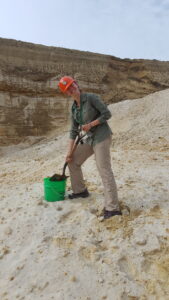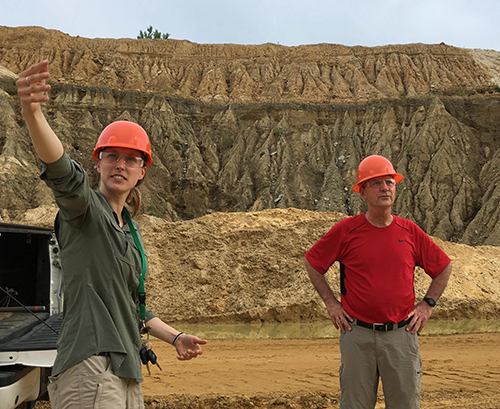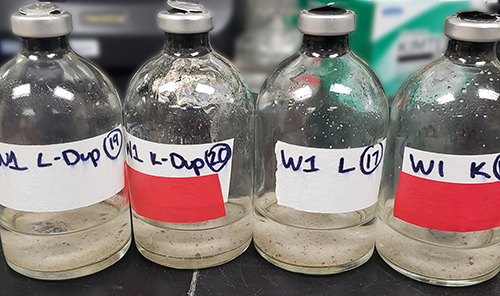New paper demonstrates the role of microbes in oxidizing pyrite
The 2023 animated movie “Elemental” imagines a world of anthropomorphized elements: earth, water, air and fire. References to chemistry are woven into the plot. There is an Alkali Theater; Mineral Lake, which displays different colors when exposed to flame; and the Wetro mass transit system whose timetable is based on the periodic table of elements.
In the non-cinematic world, there can also be a bit of drama when chemicals come together. Researchers laid out the action in “Microbially-Mediated Aerobic Oxidation of Trace Element-Bearing Pyrite in Neutral PH-Sandstone Aquifer Sediments,” https://doi.org/10.1039/D3VA00399J. It appeared in the April 12 issue of “Environmental Science: Advances,” published by the Royal Society for Chemistry.
The “setting” was Trempealeau County in west-central Wisconsin.
The “action” revolved around the region’s pyrite-bearing geological strata of an aquifer that was exposed to oxygen as a result of human activities or through natural processes such as groundwater fluctuation or a fissure in overlaying rock and soil. The research team—the cast, if you will—demonstrated the ability of aerobic microbial metabolism to promote oxidation of pyrite in this instance of now-exposed circumneutral-pH sandstone. The process results in the release of naturally occurring contaminants iron, manganese, aluminum, cadmium, chromium, cobalt, copper, nickel and vanadium into the groundwater at a scale of months to years. Contaminants, of course, could then contaminate drinking water for residents in the area of these microbially affected aquifers.

The “cast” of this research drama included Eric Roden, a geomicrobiologist scientist at the University of Wisconsin-Madison. He said the oxidation, “Would happen with or without microbial activity, but the key aspect of Lisa’s work is that microbes get energy from the pyrite and they accelerate the reaction.”
The Lisa he referred to is Lisa Haas, another critically important cast member. She is the paper’s lead author and now a geoscientist at the Wisconsin Geological and Natural History Survey. As a graduate student on this research team, she conducted experiments with oxidized Wonnewoc Formation and Tunnel City Group geologic material. Haas infused the material in unfiltered groundwater that included the native aquifer microorganisms.
The work was funded in 2019 by the University of Wisconsin Water Resources Institute (“Microbially Mediated Oxidation of Trace Element-Bearing Sulfide Minerals in Sandstones of Trempealeau County, Wisconsin”. In 2020, Haas said, “What we did is collect groundwater with some of those native microorganisms, and I put them in a vial and monitored chemical compounds that are produced as a result of this mineral dissolving and found that, with the native microbial communities, pyrite will dissolve faster than [it does] abiotically.”

Haas further investigated pyrite oxidation in Tunnel City Group overburden (that is, the formation laying on top of the more desirable Wonnewoc Formation material if you are seeking sand for frac-sand mining operations) and unprocessed sand from the Wonnewoc material. This work explored what it means if, “the sand that is not used contains pyrite and you throw that in a pond or in a pile and it rains and the water seeps down through that pile into a pond and the pyrite gets oxidized, now you’ve got frac sand ponds and then acidic metal-rich groundwater could leach down into the groundwater,” said Roden.
The implications of these oxidation-jump-starting microbes for homeowners or public water system managers are, “If there was (water) pumping—anywhere in the state—and that pumping led to input of oxygen-containing fluid to previously reduced (previously reduced means it hasn’t already been exposed to oxygen) pyrite-rich aquifers, then we’ve got a—problem,” Roden said. “If there’s frac sand mining, you can pull out pyrite-containing material that’s not used and expose that to rain depending on the nature of the solid phase geochemistry of the formation and the rates of fluid, you could again have a problem.”
This recently published work built on two previous paths of study:
UW-Madison Ph.D. students Elizabeth Percak-Dennett and Stephanie Napieralski were the first group to show that at neutral PH microbes can accelerate pyrite oxidization. Roden said, “At the very beginning, before it goes acidic and that whole set of interactions that is so well known in acid mine drainage and biomining everything else before that happens before it goes acidic, other kinds of microbes accelerate the initial oxidization process.”
As a student, Haas had also worked with others, including study lead Jay Zambito formerly with WGNHS and now a professor at Beloit College, to characterize and map the presence of sulfide minerals and their potential for surface and groundwater contamination in the Wonnewoc Formation and Tunnel City Group. They determined that these geological formations have the potential for surface and groundwater contamination associated with oxidation of naturally occurring sulfide minerals.
As a microbiologically oriented geoscientist, Roden recounted how his attempts to understand this earlier Haas and Zambito work made for humorous interchanges. “Lisa laid all this stuff out and she had all these maps. It took me a long time, but finally I got it, ‘Oh, layers within the same geological formation are oxidized is here and reduced is here…let’s study them both by way of comparison!’”
While those maps and the larger theme of this research are not going to appear on the silver screen, they do provide more than the fluff of a tub of popcorn. It’s important knowledge to share because it provides guidance about private and municipal drinking water wells in places with pyrite formations that could gain dubious fame thanks, in part, to microbial communities.
The post New paper demonstrates the role of microbes in oxidizing pyrite first appeared on WRI.News Release | WRI
https://www.wri.wisc.edu/news/new-paper-demonstrates-the-role-of-microbes-in-oxidizing-pyrite/


